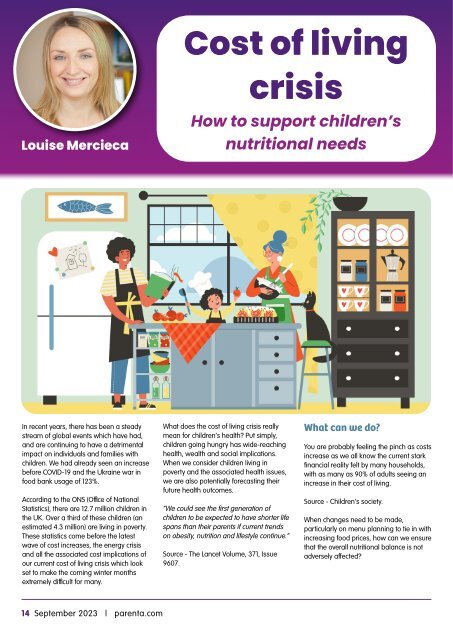September 2023 Parenta magazine
You also want an ePaper? Increase the reach of your titles
YUMPU automatically turns print PDFs into web optimized ePapers that Google loves.
Cost saving nutrition<br />
An idea to include mackerel:<br />
Louise Mercieca<br />
Cost of living<br />
crisis<br />
How to support children’s<br />
nutritional needs<br />
It is undoubtedly more expensive to buy<br />
healthy food, this is the sad reality. In fact,<br />
according to the Food Foundation Broken<br />
Plate 2021, “healthier foods are nearly<br />
three times more expensive calorie for<br />
calorie than less healthy foods”.<br />
When you consider this, it is easy to see<br />
how we have such an escalating health<br />
and wealth divide in the UK.<br />
It is possible to source nutritious<br />
economical foods but it does take some<br />
planning. When planning menus, there<br />
are several key features to always include<br />
whatever the budget. Let’s take a look at<br />
what’s needed and how to incorporate<br />
these on a budget.<br />
Essential Fatty Acids<br />
(EFA’s) and children’s brain<br />
development<br />
A lot of the energy children consume<br />
in the early years goes to building and<br />
developing their brains, in fact, 50% of<br />
a child’s daily calories are utilised by the<br />
brain. The most important nutritional<br />
consideration in this brain growth and<br />
development is the intake of Essential Fatty<br />
Acids (EFAs). These should be included<br />
three to four times a week.<br />
In recent years, there has been a steady<br />
stream of global events which have had,<br />
and are continuing to have a detrimental<br />
impact on individuals and families with<br />
children. We had already seen an increase<br />
before COVID-19 and the Ukraine war in<br />
food bank usage of 123%.<br />
According to the ONS (Office of National<br />
Statistics), there are 12.7 million children in<br />
the UK. Over a third of these children (an<br />
estimated 4.3 million) are living in poverty.<br />
These statistics come before the latest<br />
wave of cost increases, the energy crisis<br />
and all the associated cost implications of<br />
our current cost of living crisis which look<br />
set to make the coming winter months<br />
extremely difficult for many.<br />
What does the cost of living crisis really<br />
mean for children’s health? Put simply,<br />
children going hungry has wide-reaching<br />
health, wealth and social implications.<br />
When we consider children living in<br />
poverty and the associated health issues,<br />
we are also potentially forecasting their<br />
future health outcomes.<br />
“We could see the first generation of<br />
children to be expected to have shorter life<br />
spans than their parents if current trends<br />
on obesity, nutrition and lifestyle continue.”<br />
Source - The Lancet Volume, 371, Issue<br />
9607.<br />
What can we do?<br />
You are probably feeling the pinch as costs<br />
increase as we all know the current stark<br />
financial reality felt by many households,<br />
with as many as 90% of adults seeing an<br />
increase in their cost of living.<br />
Source - Children’s society.<br />
When changes need to be made,<br />
particularly on menu planning to tie in with<br />
increasing food prices, how can we ensure<br />
that the overall nutritional balance is not<br />
adversely affected?<br />
One of the best food sources of EFAs<br />
is fish, but many types of fish can be<br />
expensive. How can you ensure that you<br />
are covering the nutritional needs for brain<br />
development on a budget?<br />
Switch from salmon to mackerel. Mackerel<br />
is a much cheaper fish making it more<br />
accessible but it remains an extremely<br />
healthy source of EFAs especially omega 3<br />
fatty acids. As mackerel can be considered<br />
a ‘fishy fish’ it will need to be blended and<br />
combined with other flavours to make it<br />
appealing to young children.<br />
Instructions:<br />
1. Flake the mackerel fillets, being really<br />
careful to remove all bones<br />
2. Add to a processor<br />
3. Squeeze in the lemon juice<br />
4. Add the soft cheese and Greek yogurt<br />
and blitz to your desired consistency<br />
This pâté is a great way to get children<br />
to eat oily fish, as mackerel tends to<br />
have quite a strong fishy taste that can<br />
put some children off. This pâté makes it<br />
creamy and more palatable to children.<br />
Serve on wholemeal toast or with pitta<br />
bread with thin cucumber slices.<br />
It is a difficult time for most people and<br />
swaps will have to be made but as<br />
childhood development depends on the<br />
energy and nutrients provided to the brain<br />
at this crucial time of life, it’s important that<br />
when making economic decisions on the<br />
menu, that the nutritional elements remain<br />
present.<br />
Scan here for<br />
more recipes &<br />
resources from<br />
Louise:<br />
14 <strong>September</strong> <strong>2023</strong> | parenta.com<br />
parenta.com | <strong>September</strong> <strong>2023</strong> 15
















